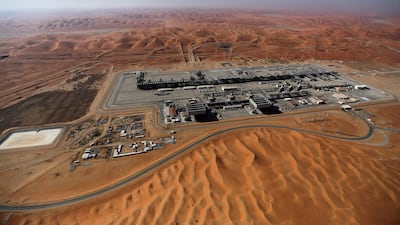Saudi Arabia has announced the discovery of seven oil and gas deposits in the kingdom's Eastern Province and Empty Quarter, as crude prices continue to rise this week on expectations of strong demand and concerns of weather disruptions.
State-run energy company Saudi Aramco discovered “two unconventional oilfields, a reservoir of light Arabian oil, two natural gasfields, and two natural gas reservoirs”, state news agency SPA reported on Monday, citing Energy Minister Prince Abdulaziz bin Salman.
The Al-Ladam unconventional oilfield, located in the Eastern Region, was discovered after an exploratory well produced oil at a rate of 5,100 barrels per day, along with about 4.9 million standard cubic feet of gas daily.
The Al-Farouk unconventional oilfield, also in the Eastern Province, was identified following the flow of Arab ultralight oil from the Al-Farouk-4 well, producing 4,557 bpd of oil along with about 3.79 million standard cubic feet of gas per day.
Meanwhile, at the Unaizah B/C reservoir, located in the Mazalej area, the Mazalej-62 well started producing light Arabian oil at a rate of 1,780 bpd.
Two natural gasfields and two reservoirs were also discovered in the Empty Quarter, a large desert expanse covering the southeastern part of the country.
The announcement comes as Saudi Arabia, which has the world's second-largest crude reserves after Venezuela, plans to increase crude production capacity to 12.3 million bpd by 2028.
Earlier this year, the kingdom, the world’s largest oil exporter, abandoned its plan to boost capacity to 13 million bpd by 2027, a decision later attributed to the continuing energy transition by Saudi Arabia’s energy minister.
Like other oil-producing countries in the Middle East, Saudi Arabia benefited from a surge in crude prices following Russia's invasion of Ukraine in 2022.
Oil prices have gained about 13 per cent this year on the back of supply cuts by Opec+, an alliance led by Russia and Saudi Arabia, as well as geopolitical tensions in the Middle East.
Oil hits two-month high
Meanwhile, oil prices also extended gains on Tuesday, trading at a two-month high, on expectations of rising fuel demand in the US and worries about potential disruptions from a hurricane.
Brent, the benchmark for two thirds of the world’s oil, was trading 0.84 per cent higher at $87.33 a barrel at 1.51pm UAE time. West Texas Intermediate, the gauge that tracks US crude, was up 0.88 per cent at $84.11 a barrel.
On Monday, Brent settled 1.88 per cent higher at $86.60 a barrel, while WTI closed up 2.26 per cent at $83.38 a barrel.
Fuel demand is expected to receive a boost from the Independence Day holiday period in the US.
The American Automobile Association has projected a record-breaking 70.9 million travellers for the July 4 week, representing a 5 per cent year-over-year rise and an 8 per cent increase compared with 2019 levels.
Hurricane Beryl, a category 5 storm that has swept across several islands in the southeastern Caribbean, could disrupt operations in the Gulf of Mexico region, which accounts for about 15 per cent of total US oil and gas production.
“Hurricane Beryl is not expected to impact operations in the Gulf of Mexico immediately but could cause disruptions later in the week,” said Ipek Ozkardeskaya, senior analyst at Swissquote Bank.
“Risks remain tilted to the upside, the next target for the bulls stands at $85 a barrel level [for WTI], where we should see support and rebound given that the soft manufacturing data from the US and China at the start of the week don’t give a further support,” she added.
Oil prices rose by about 5 per cent in June as Opec+ production cuts kept supply in check and summer travel picked up in the Northern Hemisphere.
Brent’s recovery from a low of $77.5 barrel on June 4 “represents a correction from the steep – and, in our view, largely unwarranted – sell-off in the wake of the most recent Opec+ announcement”, said BMI, Fitch’s research arm.
“However, firmer fundamentals have also played a role. Global oil demand rises seasonally over the summer months and key exporters – notably in Mena – are forced to curb their exports to meet higher domestic consumption,” BMI added.
Futures dropped after the alliance of producers met last month with a plan to gradually unwind voluntary curbs of 2.2 million barrels per day, starting from October 2024 and continuing on a monthly basis until September 2025.
That comes as global oil demand is projected to be 3.2 million bpd higher in 2030 compared to 2023, driven by increased oil consumption in emerging Asian economies, the International Energy Agency said last month.
The growth is particularly due to higher transport-related oil use in India and increased demand for jet fuel and petrochemical feedstocks, especially in China.
Meanwhile, total supply capacity is expected to increase to nearly 114 million bpd by 2030, surpassing the projected global demand by 8 million bpd, the Paris-based agency said.

